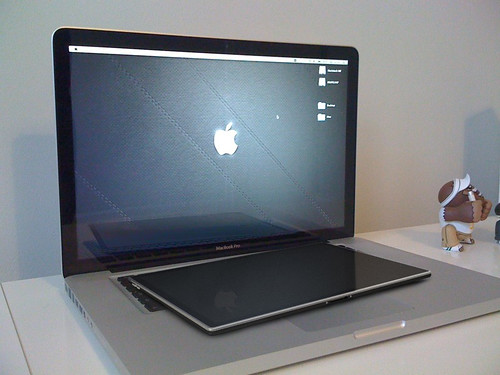Apple iPad Needs Live Video

Nice job of rendering the new iPad by Dustin Curtis. We suspect it’s quite accurate.
The user interface is what gives the iPhone — and soon the iPad — its universal appeal. Techno adults and young children get how to use the icons/apps right away. And we love it. What a difference it makes. Sure, apps are just a bunch of code and scripts, but people love them. Simple and intuitive. This renders all other operating systems into the stone age. Brilliant.
So, as Apple is about the turn around an entire industry, we wondering whether it will one day have one more "killer app." How about live TV? Today’s New York Times (print edition, ironically published on their Web site last night) gives us a comprehensive piece on what we’d expect to see on 27 January 2010, when Steve Jobs takes the stage in San Francisco. With the App Store, people just might get comfortable with paying for premium content. Some already have.
Word has it the iSlate will have more room for various antennas (maybe a push-button one, too). Toggling between WiFi and 3G is simple, so why not add a few more? Use some of the broadcast spectrum for live local TV reception? Add an S-band antenna for live audio or video from an orbiting satellite? Or use Qualcomm’s Flo TV infrastructure. SES tried it two years ago and it worked nicely, but then went and killed what it was based on: the IP-PRIME platform. Sirius XM is broadcasting video using S-band, and Solaris Mobile is trying it in Europe — but satellite reception needs a clear line-of-sight (duh).
If the satellite operators had a little more vision, perhaps they’d take a chance on co-developing a model for their paying customers (TV networks, both broadcast and cable) to really make something innovative. TV stations apps are out there, and streaming live TV is possible — although not at the scale required for mass audiences. But if we’re to tap in to the existing RF model of VHF, UHF and satellite, why not give it a go?
Mark Cuban correctly identified a unique opportunity for satellite, cable or telco to get into a new model for video entertainment:
Let me add a couple other thoughts. There are many that think that video over the internet will “set them free” from having to deal with a small number of big companies (think cable, telco). . If that is what you think, you better think again. There are maybe 3 companies that can stream to 1mm or more simultaneous users. Google, Limelight and Akamai. And that 1mm simultaneous users isnt just for your content. That is for EVERYONE’s content and they cant get much beyond 2mm without big problems. More importantly, if you want to stream your content to millions of users at once, its going to cost you an incredible amount of money.
Which leads me to a lesson for all you netizens who are jazzed up about over the top video. If you really believe the demand is there and your content will command 1mm simultaneous users , its probably cheaper to pay Directv, Dish Network and Comcast to create a channel for you and let your viewers watch it on tv.
Let that sink in. Its going to be cheaper to have the big traditional cable distributors offer your content to viewers than it will be to reach a large audience on the net. Thats for a one time offering. If you plan on doing it more than once or on a regularly scheduled basic, there is no question its cheaper to do it this way. And the picture quality will be dramatically better.
In fact, that is probably a great business opportunity for satellite, telco and cable companies. Open up times to bid to offer content over their networks. You want channel 1020 on Directv, its X dollars per hour minimum or the best price bid. Here is how you provide your content to us. You can buy marketing from us as well. Directv, Dish, Comcast could make a boatload of extra money offering this service.
And i can give you one more option. It may be cheaper to go to a movie theater chain and pay them to broadcast the content you want people to see via digital to their theaters. As long as its a slow night and they can sell popcorn, I can assure you it will cost you less than a content distribution network would charge to deliver to thousands of viewers.
Maybe someday over the top video will be a realistic alternative to traditional distribution of content, but its not now and its not this year or next or the next and probably not the year after that.

By co-developing, we mean lowering the cost of satellite transmission. Expecting 80% gross margins for satellite bandwidth is not a good place to start. Think about it, satcom guys, and call Netflix — they’ll listen.